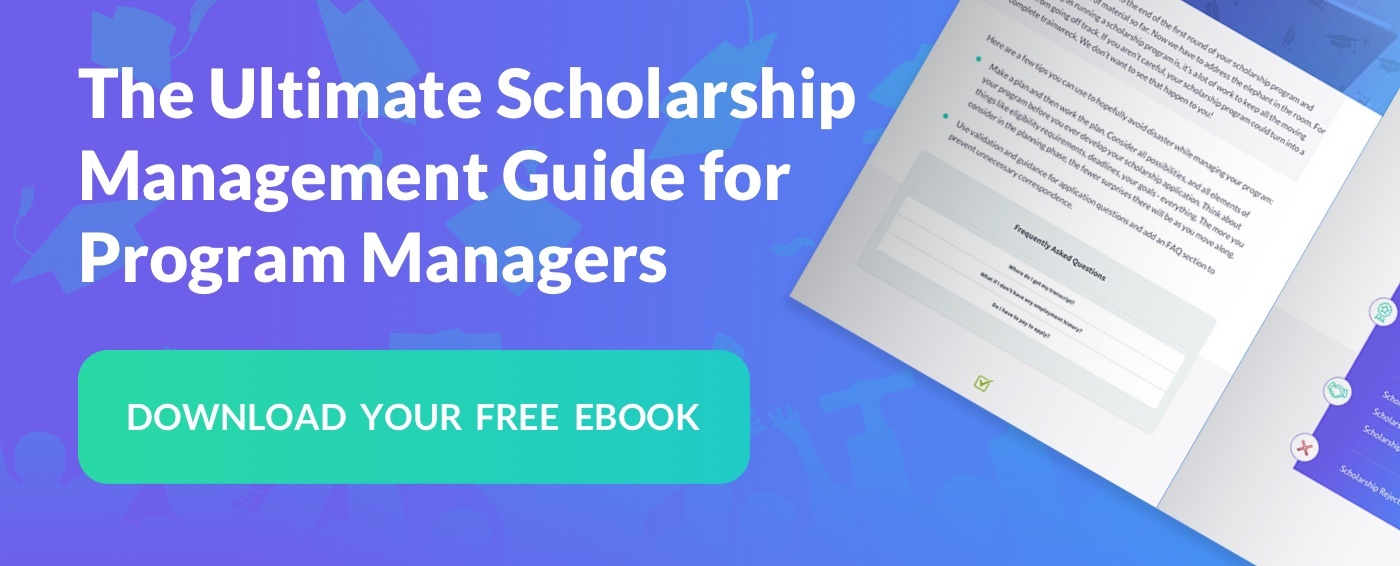How To Have More Time as a Scholarship Program Manager
Whether you’re running an inaugural scholarship program, or you’ve been doing it for many years, one thing always remains a constant. Scholarship management takes a lot of time.
Program managers and teams attempting to do it without the help of scholarship management software will spend even more hours on everything from filtering applicants to making the final selection of the award recipients.
If you’d rather save your energy and put it towards something else, you’ve come to the right place. In this post, we’ll discuss the different ways you can improve your scholarship application program through automation using software.
The Bottlenecks in Scholarship Management
There are so many moving parts in a scholarship program. First, you have to put in the groundwork to start one. Then comes promoting the program, acquiring the applications, and inevitably the selection of the recipients.
The steps between launching and choosing the recipients are laden with bottlenecks. Just a few of the tasks that bog down the process include, but aren’t limited to:
- Reminding applicants of pending deadlines
- Addressing correspondence about the application questions
- Evaluating applicants once all applications have been submitted
- Notifying the applicants who the recipients are
Reminding applicants of pending deadlines
While it’s true that many organizations already have email software in place to somewhat automate and manage correspondence with hopeful applicants, it can still be quite time-consuming to reach out to everyone without a proper plan in place.
Your program administrators may find themselves having to double and triple-check their lists to ensure that the proper reminders went out to each person who filled out an application.
That’s where scholarship management software comes in. From broadcast reminders and auto-responders, using the right software will give you the ability to quickly and efficiently inform both applicants and evaluators about things like status notifications and important reminders.

For example, using software, you could send an email and a text message 90 days, 30 days, and a week prior to the deadline reminding candidates to submit an application.
Other examples of broadcast messages you could send scholarship applicants are:
- Recommendation requests for teachers, friends, employers, etc… sent on the applicant’s behalf
- Reminders to submit qualifying information such as ACT and SAT scores
- Thank you messages for submission of application materials and
- Status updates on when you are planning to announce the award recipients
Simple messaging like this can inspire action amongst your potential applicants to complete their forms and submit them. It also helps them stay informed about the progress of the scholarship so managers and evaluators can avoid the unnecessary time spent responding to questions like:
- When is the deadline?
- Have you chosen the recipients yet?
- Do you have all of my application materials?
- When will we hear who won? Etc…
Addressing correspondence about the application questions
There are few things as frustrating for a program team as having to stop what they are doing multiple times a day to answer emails from applicants about the meaning of a question, or confusion over how to submit materials.
Even with copying and pasting answers, the amount of time wasted addressing the same question over and over again can add up quickly. When using quality scholarship management software you can eliminate many of these questions by including tips and tools directly in your application.
For example, you can all but prevent questions about how to answer a prompt about grade point average (GPA) by utilizing answer validation in your form to ensure that only certain values are placed in the answer box. Or, if you get a lot of frequently asked questions about how to answer an essay question, you can include suggestions within your instructions that address them from the outset.

Additionally, create a list of frequently asked questions with answers so that the applicants can get the help they need in the application form without having to contact you.
Analyzing applicants once all applications have been submitted
Perhaps the most time-consuming stage of a scholarship program is the analysis phase. This is in part due to the fact that when scholarship money is up for grabs, without proper barriers in place, anyone could try applying. Again scholarship management software comes to the rescue and saves countless hours for program managers.
With pre-qualification settings at the beginning of your process, you can avoid most if not all unqualified applicants from applying in the first place. You can also add additional qualifiers and application rules that change the questions based on the user’s answers to your application. This can aid your team in removing lesser qualified applicants from the group of potentials as they go along in the application process.
Once all the applications are completed, that’s when your software can really flex its digital muscles. Using elements such as auto-scoring, automatic calculating, report generation, and more will help your managers narrow the pool of applicants that much faster.
From there, with your final, filtered pool, you can quickly assign applications to your team of reviewers so that they have a much smaller group of forms to evaluate. Then, each member of your team can present the candidates that are worth considering to the rest of the team for you all to agree on the official award recipient or recipients.
Notifying the applicants who the recipients were
If you have been using scholarship management software, you’ve likely eliminated much of the correspondence so far thanks to sending out status updates and including tips and suggestions in your application. Now, all that is left is to notify the group of applicants about who has been selected as a recipient. Using software makes it easy to do this task with minimal effort as well.
Once the recipient or recipients are chosen, you can send out one email to everyone announcing the winner(s). With award management features, the email can even specify the award amount on a per applicant basis.
There may be some questions from applicants about why they weren’t chosen, and those inquiries can be addressed with messages too. One simple email can be written up with an explanation of how the evaluation process worked, and what led to your team’s decision. You can include this explanation in your award notification, or simply send it as a custom message in the event questions arise.

A Good Scholarship Program Manager Works Smarter
We’ve barely scratched the surface of what top-of-the-line scholarship management software can do for your team. We may be biased, but we believe that our software, SmarterSelect, is the best program on the market for building and executing a scholarship program efficiently.
Whether you have a few applicants, or a few thousand, you can streamline the process of analyzing applicants, and remove the bottlenecks that come with choosing your recipients.
The goal of your scholarship management software should be to avoid wasting precious time. That’s exactly what SmarterSelect does for you and your team. We give you your time back.
Our software also integrates with more than 2,000 applications to help you automate your systems and processes even further.
We’ve helped countless program administrators make quick work of their own scholarships, and we can help you too. Click here to download our in-depth scholarship management guide for program managers.
FAQs
1. What are the common bottlenecks in scholarship management?
Here are some of the most common bottlenecks in scholarship management:
- Reminding applicants of pending deadlines
- Addressing correspondence about the application questions
- Evaluating applicants once all applications have been submitted
- Notifying the applicants who the recipients are.
2. How can I remind scholarship applicants of pending deadlines using broadcast messages?
Common examples of broadcast messages you could send to scholarship applicants are:
- Recommendation requests for teachers, friends, employers, etc., sent on the applicant’s behalf
- Reminders to submit qualifying information such as ACT and SAT scores
- Thank you messages for submission of application materials and
- Status updates on when you are planning to announce the award recipients.



